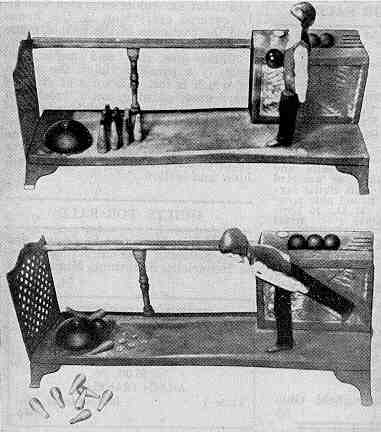Bowling Alley Bank
by F.H. Griffith - HOBBIES Magazine - November, 1954
 A very rare and much sought for mechanical bank occupies the 33rd
position in our numerical classification of the mechanical banks. This is the Bowling
Alley, a fragile and easily broken bank. Of course, this is probably the main factor
contributing to its great rarity. Also it’s very likely there were not too many of
these banks manufactured.
A very rare and much sought for mechanical bank occupies the 33rd
position in our numerical classification of the mechanical banks. This is the Bowling
Alley, a fragile and easily broken bank. Of course, this is probably the main factor
contributing to its great rarity. Also it’s very likely there were not too many of
these banks manufactured.
The bank was patented by L. Kyser of Philadelphia, Pa., assignor to Kyser & Rex of the same city under Patent No. 222,058 dated November 25, 1879. It was manufactured, of course, by Kyser & Rex and the actual bank follows closely the design and mechanism as shown in the patent papers. Also, several old trade catalogs have turned up that picture and advertise the bank for sale.
The bank shown is from the very fine collection of the late F.W. Wieder of Berkeley, Calif. He was an avid collector of mechanical banks and his great interest was shared by Mrs. Wieder who is keeping the entire collection intact. No items from the collection are available, and naturally Mrs. Wieder has a sentimental attachment towards the banks since she and her husband had a mutual interest in them. She has graciously cooperated so that we may give proper recognition to a fine mechanical bank, the Bowling Alley.
The background of the bank is rather interesting. It was originally found about 1938 by James Whitfil a former antique dealer of Pittsburgh, Pa. It then found its way into the possession of a billiard hall proprietor in Washington, Pa., where it stayed for some years. A lot of effort was put forth by a number of collectors in trying to pry the bank loose and many trips were made to Washington, Pa., with no success. However, a few years ago Mr. Wieder finally became the successful owner of the bank and it found a home in a fine collection.
The bank is in good paint condition which was revealed after a proper amount of cleaning. There is more than an average amount of original paint on it. The main body of the bank is basically green with some black striping. The grill work is a faded orange and the designs on the coin box are painted blue, yellow and green, and the top is brown. The figure of the bowler has black trousers, blue vest, and a white shirt.
The bank is pictured before and during the action. In operation the top of the coin box has three different size slots to take the various size coins. On inserting a coin in one of the slots a lever is engaged which causes the man to lean forward. The bowling ball rolls from his right hand and continues down the alley striking the pins and ringing the bell. The man returns to position automatically and when another ball is placed in his hand and the pins replaced it is again ready for action. As with some of the other mechanical banks, a nice feature is the fact that the coin causes the action to occur.
The bank is in original condition with no repairs. The bell, the pins, and the bowling balls were missing when Mr. Wieder obtained the bank, but this was to be expected since after all the pins and the balls were separate items and very easily lost. A bell of the same size as the original was obtained from a Creedmore bank.
The Bowling Alley offers a real challenge to the mechanical bank collectors and so far there is only one of these banks known to exist in any private collection.
